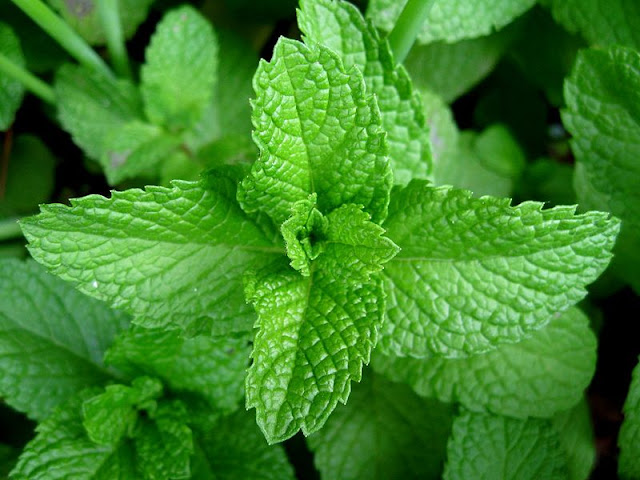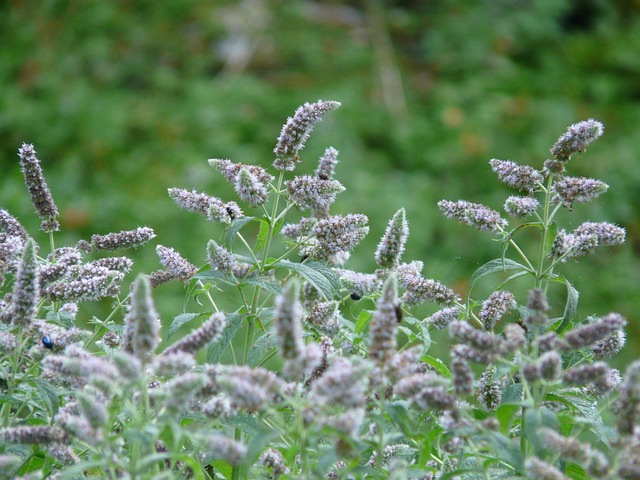Can Dogs Eat Mint? Is Mint Safe For Dogs?
 |
| Can Dogs Eat Mint? Is Mint Safe For Dogs? |
Can My Dog Eat Mint?
Maybe. It depends on the variety of mint. Most varieties of mint are perfectly safe for dogs. Some dog treats and some dog foods contain mint as it refreshes the breath and aids digestion. But dogs should not eat more than a few leaves a day. Otherwise, your pet may have gastrointestinal problems. Only one mint variety - the English pennyroyal (pictured below) - is toxic to dogs. It can grow in most parts of the United States, except for the colder regions. If your dog has vomiting, diarrhea, or weakness after eating mint, call your veterinarian immediately.
Are Mint Leaves Bad For Dogs?
The mint leaves (Mentha spp.) Are known for their aroma and their distinctive and pleasant taste. Members of the mint family are tenacious perennial herbs that grow in the US Department of Agriculture Hardiness Zones 3 through 10, depending on the species. Although many types of mint are safe for dogs and are even included in some types of dog treats, others are toxic and should be avoided in a dog-friendly garden.
Mint Factories
Wild mint (Mentha arvensis) is a common perennial that grows in USDA zones 4 through 9. This plant, along with other types of mint, such as peppermint (Mentha x Piperita) and spearmint (Mentha) are among the most common. species grown to flavor food. Peppermint and spearmint grow in USDA zones 3 to 9. When you grow a member of the mint family (Lamiaceae), take precautions to prevent these invasive plants from spreading in your garden, for example by planting in pots. You can bury the pots in the soil if you wish, to keep the plant roots in check.Toxicity
Mint species, including wild mint, spearmint, and peppermint, are not toxic to dogs, according to the Continental Kennel Club. The American Society for the Prevention of Cruelty to Animals reports that the only mint species of the genus Mentha that is toxic to dogs is the English pennyroyal (Mentha pulegium). According to the California Invasive Plant Council, this plant, also known as pennyroyal from Europe, grows in zones 5 to 9 of the USDA and is considered moderately invasive. English pennyroyal contains pulegone, a chemical that is not only toxic to dogs, but also to humans. The polygala can cause liver damage and organ failure if ingested in large amounts, warns the University of California at Davis.Canine Ingestion
If your dog is eating an English pennyroyal plant, expect him to have diarrhea, vomiting or weakness. Get Fido immediately from the vet so that he can provide supportive care and possibly induce vomiting. For most other types of mint, there is no need to worry if your dog is eating them. In fact, a few leaves of wild mint, peppermint or spearmint can even refresh your puppy's breath or facilitate digestion. Many recipes for dog treats require mint leaves, and even commercially available dog treats contain them. As with any flora, limit the ingestion of the dog to a few leaves a day to avoid any gastrointestinal distress due to excessive consumption of plant material.Other Safety Mint
Although not a member of the genus Mentha, fresh mint is part of the mint family. According to the Seattle Times, this plant is safe for dogs and cats. Cats mint grows in USDA zones 3 through 8. Another member of the mint family that is not part of the Mentha genus is perilla mint (Perilla). Perilla mint is used in Asian cooking and grows in USDA zones 5 to 10. This plant, although used for its minty taste, is considered toxic to dogs and livestock, so avoid it in your garden warns the Colorado Water Garden Society.Some Consider Mint For Dogs As Safe
 |
| Can Dogs Eat Mint? Is Mint Safe For Dogs? |
Although the ASPCA notes that it is toxic, the SFGate indicates that some Mentha spp. are safe and are found in certain dog foods and treats (such as biscuits and dog biscuits) to help freshen breath and aid digestion.
A delicious example that your dog friend will appreciate is the Benefit All Natural dog biscuits, which contain pumpkin, rosemary, peppermint, vitamin A, B12, and C.
chose Pennyroyal English as a poisonous species. Perilla mint is also considered toxic to these animals.
It is also claimed that only the English pennyroyal has a toxic pulegone for dogs. However, this is not the case. Our research indicates that spearmint, peppermint, and other Mentha species are affected.
According to Love Joys Pet Foods, the symptoms of poisoning are: "listlessness, bloody nose, coughing up blood, diarrhea, falling into a coma, breathing difficulties, vomiting, convulsions, and even death. "FDA has designated polyglots as carcinogenic to humans."
Some of the mint benefits for dogs mention are:
1. Nutritive - contains vitamins A and C, minerals including folate, iron, manganese, calcium, dietary fiber, and antioxidants.
2. It has antimicrobial properties, i.e. it is antibacterial, antiviral and antifungal.
3. Promotes fresh breath by eliminating the oral bacteria responsible for the nauseating breath of the dog.
4. It has rosmarinic acid that may help relieve some symptoms of allergies, especially those of the season.
5. Is Menthol Vital for Nasal Decongestion - Removes Thick Mucositis
6. It helps digestion, reduces stomach upset, gurgles of stomach sounds or gas, movement-related diseases, etc.
7. It has anti-inflammatory properties.
8. repels fleas
Because of these benefits, you will get many recipes for homemade mint dog treats online. Consult your veterinarian before using any of them.
Some dogs may like these herbs, but some may not like their aroma and taste. Even if they like it, the recommended dosage is about one or two leaves.
Remember that excessive amounts of herbal fibrous food can be difficult to digest for dogs and can lead to stomach upset, vomiting and diarrhea.
Why Do Dogs Like Mint
 |
| Can Dogs Eat Mint? Is Mint Safe For Dogs? |
For humans, peppermint and spearmint are breath-freshening and can help relieve indigestion. It is also delicious in many drinks and treats. Dogs also often appreciate the taste of mint, which is found in many mass-produced dog treats, designed to help them clean their teeth and freshen their breath. Mint can easily be grown in your garden and is an ingredient in many homemade dog recipes treat on the internet. Even if your dog likes mint, it's important not to allow him to eat too much mint leaves in your garden or give him mints created for human consumption. Although most mints are not toxic to dogs, English Pennyroyal is and should always be avoided.
The Root Of The Behavior
Dogs are not usually adventurous eaters. Unlike humans, they do not consume a variety of spices in their food regularly. As their digestive system is also different from yours, what you find useful is not always worth it for your pet. Dogs like to eat mint, but not for the same reasons as you. Dogs like to eat on the leaves, just like they can eat on the grass. It's not necessarily the taste they're looking for, but the digestive benefits that green vegetables can provide. It's not even proven that mint helps the dog's digestive system like yours; the fact that he eats mint maybe just a coincidence. If you grow mint in your garden and your dog spends most of his time eating in this area, he is most likely a mint lover. If he spends his time also nibbling in your garden, he is just tasting his environment. On the market, several products are green, have a mint scent and a slight taste, and are intended for cleaning teeth and bad breath of dogs. Most dogs seem to enjoy these chewy treats and the owners report a difference in their puppy's breathing and clean canines. The Internet is full of recipes for dog treats that use mint in the recipe. However, most recipes require a minimum, as they can be strong and too powerful for your four-legged friend. Mint can inhibit bacterial growth in its mouth and it is a natural repellent against fleas. Candies containing mint are a great way to soothe your palate, clean your mouth and protect it from pests at the same time. Mint can also be in the form of an essential oil. Many people use essential oils for healing as well as for flavor in cooking. Although some essential oils are approved for dogs, mint oil can be toxic. It is not recommended for topical use or pastry use in dogs. It's best to stick with commercial products and recipes created for dogs, not humans.Other Solutions And Considerations
If you are tempted to give your dog mint to treat bad breath, take a moment to look for the source of his stinking snout. Do you wash your teeth regularly? If he has cavities or gingivitis, it is probably the source of his bad breath. There is a plethora of products on the market, ranging from special brushes to toothpastes, even for dogs, to help maintain oral hygiene. A coach can show you how to brush your teeth and how to reward him for obeying. It could also have an infection in the mouth or a digestive disorder. Providing mint will only temporarily mask his problem. Often it's just food stuck in his teeth. If you brush regularly and still have bad breath, it is recommended to consult a veterinarian.Conclusion
 |
| Can Dogs Eat Mint? Is Mint Safe For Dogs? |
Mint is natural, refreshing and can soothe your belly. Dogs can enjoy the flavor, but their consumption should be limited to products specifically designed for dogs or home-made. Mint sweets contain sweeteners that are not good for your dog. Some forms of mint can be toxic, and too much fresh mint can cause digestion problems to your pet. Essential oils are too strong for your pet and should also be avoided.
Related Post :
Can Dogs Drink Tea
Can Dogs Drink Coffee

Comments
Post a Comment